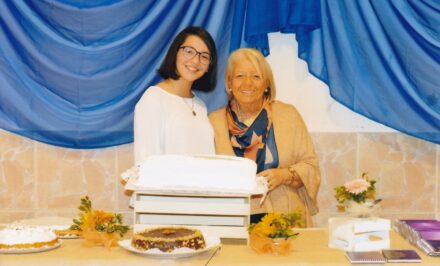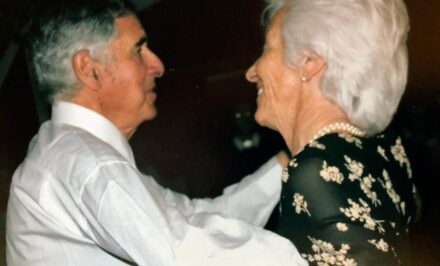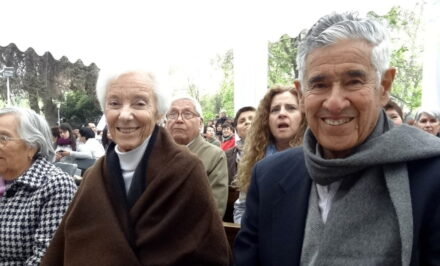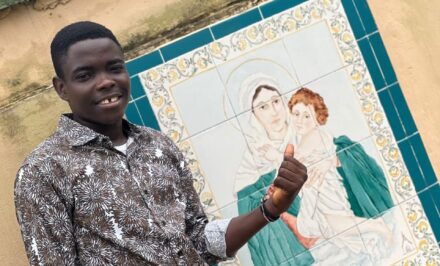 AUSTRIA, mkf. “She was simply our mother,” was the spontaneous response received when asked what this Sister of Mary meant to them. She arrived in Austria in 1972 along with two other Sisters to carry out the mission of her life: to prepare a nest for Schoenstatt in Austria. Father Kentenich spoke these words, and they demonstrate her efficacy. She is still remembered among the Austrian Schoenstatt Family after almost forty years: “She arrived at St. Georg Kagran on August 29, 1972 at 11:00 a.m.” Sister M. Elmengard Pimpl died in Kösching on January 15, 2011, at the age of 87. She was one of those pioneers who wrote Schoenstatt history from the Covenant of Love.
AUSTRIA, mkf. “She was simply our mother,” was the spontaneous response received when asked what this Sister of Mary meant to them. She arrived in Austria in 1972 along with two other Sisters to carry out the mission of her life: to prepare a nest for Schoenstatt in Austria. Father Kentenich spoke these words, and they demonstrate her efficacy. She is still remembered among the Austrian Schoenstatt Family after almost forty years: “She arrived at St. Georg Kagran on August 29, 1972 at 11:00 a.m.” Sister M. Elmengard Pimpl died in Kösching on January 15, 2011, at the age of 87. She was one of those pioneers who wrote Schoenstatt history from the Covenant of Love.

Almost fifteen years after her farewell from Austria, many Schoenstatters from this country made the long trip to Kösching to be present at her funeral. She was the one who made Schoenstatt known to the entire first generation of the current Austrian Schoenstatt Family; she led it, she conquered it for the founding of the Movement. One Austrian said during the funeral on January 19th, “The first generation, the generation that said ‘yes, we will build Schoenstatt in Austria,’ emerged from contact with her.”
Father Tilmann Beller, who worked with her for many years during the founding of the Schoenstatt Movement in Austria, presided at the Funeral Mass. She who “had God’s intervention. One remains speechless. She was convinced that God worked through her, with her, in her.” That is the faith that pioneers need. And she was a pioneer.
Who was (and still is) M. Elmengard for the Schoenstatt Work in Austria?
“She revealed a new world to me”
 Sister M. Elmengard was born on December 5, 1923 in Royan, Marienbad (which is now a territory of the Czech Republic). When she finished school, she stayed for some time with Father Kulmus, a relative of hers and perhaps one of the first Schoenstatt Fathers, at Ennabeuren in southern Germany. That is where she learned about Schoenstatt. She related:”A new era has begun for me. I learned a new ideal of holiness, ‘Schoenstatt:’ It revealed a new world to me, and it has filled me so profoundly that from that moment I knew that I had to give myself as a gift to this Work.”
Sister M. Elmengard was born on December 5, 1923 in Royan, Marienbad (which is now a territory of the Czech Republic). When she finished school, she stayed for some time with Father Kulmus, a relative of hers and perhaps one of the first Schoenstatt Fathers, at Ennabeuren in southern Germany. That is where she learned about Schoenstatt. She related:”A new era has begun for me. I learned a new ideal of holiness, ‘Schoenstatt:’ It revealed a new world to me, and it has filled me so profoundly that from that moment I knew that I had to give myself as a gift to this Work.”
In 1946 she and her family – like all Germans – were expelled from the Czech Republic. She found a new home in Ennabeuren, where at the beginning, she worked in the city. In November of 1948, she entered the community of the Schoenstatt Sisters of Mary. She worked in Southern Germany and Bavaria for many years as a catechist and parish assistant until 1972, when she found the mission that filled her life: Schoenstatt in Austria.
For Schoenstatt in Austria
 In 1972 three Sisters were sent from Liebfrauenhöhe (the provincial house of the Sisters in southern Germany) to Austria with the express mission of opening a daughter house to found the Movement. Father’s bronze death mask was a precious symbol for the nascent Schoenstatt Movement that the Sisters took to Austria so that the Movement would be born cradled within the spirit of the Father and Founder.
In 1972 three Sisters were sent from Liebfrauenhöhe (the provincial house of the Sisters in southern Germany) to Austria with the express mission of opening a daughter house to found the Movement. Father’s bronze death mask was a precious symbol for the nascent Schoenstatt Movement that the Sisters took to Austria so that the Movement would be born cradled within the spirit of the Father and Founder.
Sister M. Elmengard and the other two Sisters of Mary settled in Vienna at the end of 1972 and initiated a new founding – although Schoenstatt had existed there before their arrival. In fact, some Sisters of Mary had arrived and been in Vienna since 1929 (the daughter house was closed in 1936) and it was the Pallottine Fathers in Vienna who spread the first seeds. Two Sisters of Mary from Batschka, currently a territory of Serbia and Hungary, worked in Vienna among their compatriots since the Fifties. In Pazmaneum, a Hungarian seminary in Vienna, the first contacts emerged that later were essential for the beginning of the Schoenstatt Movement in Hungary.
Nevertheless, a perceptible Schoenstatt Movement did not exist in Austria during the decade of the ’70’s.
“We had the feeling of being the founding generation,” one of the youth from that time said. “There was a small Branch of older mothers and here and there some families and other people … but only a few. Once in a while, some Schoenstatt Fathers visited, but there was not a growing Movement. There were attempts to connect with each other when they met other Schoenstatters, but they were very small circles. In reality, no one knew about Schoenstatt in Vienna or what it was. It was a new founding. Then Sister M. Elmengard arrived, and she began to work systematically, constantly, radically, and filled with enthusiasm. “She was a pioneer in a new country. Schoenstatt in Austria would not have been born without this woman,” stated one testimony. And this is the key word: Schoenstatt in Austria.
Father Kentenich built Schoenstatt here
When you listen to the Schoenstatters of the early times, a panorama emerges: It was a truly authentic beginning in Austria. Everyone’s conviction is that what exists now and for which Austria is grateful is thanks to her and Father Beller, who she called on very quickly to conduct the first meetings. Schoenstatt emerged in a country that speaks the same language as its elder neighbor, Germany, with its long Schoenstatt history, “not as an imported Schoenstatt, rather as our Schoenstatt.” Frequently it was not understood by its compatriots because it never used material from Germany, rather it always produced new Austrian material in order to keep the national identity of the Schoenstatt Family from Austria.
Someone recalled: “Sister M. Elmengard and Father Beller reflected greatly about the Austrian mentality. It was interesting that someone from the outside would tell us how we are. Much later I understood what was behind it: according to the words of our Founder, in order for Schoenstatt to be authentic, it should pass through the minds and hearts of the natives of a country. She wanted to understand what was typical of us, the Austrians. And through this, she gave us enormous self-esteem: Father Kentenich built Schoenstatt anew in Austria; he built his Movement here. This was our faith as the first generation: Father Kentenich built Schoenstatt anew here in Austria, and he did it through us.”
Sister M. Elmengard and Father Beller were two charismatic personalities, who complemented each other brilliantly. This was the beginning of the Schoenstatt Movement in Austria, as it exists today. “She worked for Schoenstatt as a wood-cutter during a freeze, always injecting strength, she never took it easy. She was a genius at attracting highly qualified personalities, who were natural leaders who got along with her,” Father Beller said in describing her.
Mother of the first generation
 The “mother of the first generation” sought to fulfill her mission and to give the Movement a nest: a Shrine. During the weekends, she traveled with the Sisters looking everywhere for land and houses. It was too damp, too small, too big, and too hot: she was demanding. The nest had to be good. And ten years after her arrival, the Shrine in Kahlenberg was blessed.
The “mother of the first generation” sought to fulfill her mission and to give the Movement a nest: a Shrine. During the weekends, she traveled with the Sisters looking everywhere for land and houses. It was too damp, too small, too big, and too hot: she was demanding. The nest had to be good. And ten years after her arrival, the Shrine in Kahlenberg was blessed.
She made contact with only those she could above all through work at the parish. The current president of Austria participated in her first group of altar boys. She knew how to enthuse the youth as well as families for the Schoenstatt ideals. She organized the first meetings for the Branches. She was also responsible for getting hearts to slowly understand the ideal of a Holy City; she “imported” this ideal from Stuttgart, because it was the right one! She awakened vocations, vocations for Schoenstatt, and vocations for all the Schoenstatt family communities, Women’s Federation, Sisters of Mary emerged from contact with her.
And she was like the strong nest of the nascent Schoenstatt Family. She accompanied everyone and everything. “This was very important for us. We always had the feeling that WE built Schoenstatt. But SHE was in the middle of everything, and she gave us support. She symbolized Schoenstatt.”
“Everything that happened in Schoenstatt in Austria passed through the heart of this woman.” This testimony says it all, and the symbol of this was “Sister’s office” close to the Shrine in Kahlenberg. “She was there with the picture of the MTA on the wall besides Father Kentenich in front of an enormous desk; she and frequently Father Beller were behind,” that is what a description says. Decisions of what had to be done and questions about vocations were clarified in the office.
Some of her words reveal a bit of her soul. One of the youth of that time recalls them. She admired Joseph Engling very much. “He died so young and so many are still oriented by him.” Joseph Engling’s radicalism touched her. Perhaps she was never aware that she was like a Joseph Engling for Austria. You did not have to die young to do it.
In 1993, she had a vascular cerebral incident, three years later she was taken to the provincial house in Kösching. “Her” Austrians constantly visited her there. She prayed and offered her sacrifices for all the people with whom she had worked in Austria. She received many telephone calls and letters with petitions for prayer. She was very well informed about the Schoenstatt Family in Austria until the end.
“Yes, it is very impressive. Totally and completely for God and for her great mission,” said a 22 year-old youth from the Austrian Schoenstatt Girls’ Youth. She did not know her personally, but she does know those who were educated by her.















Amazing! I give thanks for those like her who are so faithful! Their fruit for the Kingdom of God is so evident!
Her work is not over, I’ll warrant… she’s probably up there conversing with Josef Engling and Father and praying for her children still.